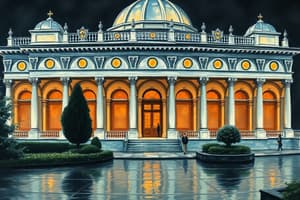Podcast
Questions and Answers
What is a characteristic feature of Byzantine architecture?
What is a characteristic feature of Byzantine architecture?
- Emphasis on horizontal lines
- Presence of one great dome (correct)
- Pointed arches
- Extensive use of glass
Which statement best describes Gothic architecture?
Which statement best describes Gothic architecture?
- It is characterized by the use of heavy walls and ribbed vaults.
- It utilizes plain exteriors with little decoration.
- It features flying buttresses and emphasis on verticality. (correct)
- It employs rounded arches and thick walls.
Renaissance architecture is distinguished by the adaptation of which design elements?
Renaissance architecture is distinguished by the adaptation of which design elements?
- Heavy, fortress-like walls
- Elaborate sculptural ornamentation
- Presence of clustered colonnettes and semi-domes
- Classical order and design with horizontal lines (correct)
What describes the use of materials in Roman architecture?
What describes the use of materials in Roman architecture?
What feature is prevalent in Baroque architecture?
What feature is prevalent in Baroque architecture?
What is the primary focus of contemporary architecture?
What is the primary focus of contemporary architecture?
Which of the following best describes the principle of 'form follows function'?
Which of the following best describes the principle of 'form follows function'?
What is a key requirement for architectural designs to be considered interesting?
What is a key requirement for architectural designs to be considered interesting?
Which of the following materials is NOT traditionally used in architecture?
Which of the following materials is NOT traditionally used in architecture?
Which construction system is characterized by a series of beams and supporting columns?
Which construction system is characterized by a series of beams and supporting columns?
What architectural style is known for using Greek columns?
What architectural style is known for using Greek columns?
Which of the following elements is NOT considered a fundamental aspect of architecture?
Which of the following elements is NOT considered a fundamental aspect of architecture?
What does the term 'light and shadow' refer to in architecture?
What does the term 'light and shadow' refer to in architecture?
Flashcards
Byzantine Dome
Byzantine Dome
Byzantine architecture is known for a large central dome supported by semi-domes and half-support domes; it has plain exteriors with carved decorative elements called colonnettes and basket capitals.
Roman Architecture Feature
Roman Architecture Feature
Roman architecture used cement and bricks, and often had multiple stories.
Romanesque Feature
Romanesque Feature
Romanesque architecture had thick, fortress-like walls and ribbed vaults but was less massive than Roman structures.
Gothic Architecture Key Element
Gothic Architecture Key Element
Signup and view all the flashcards
Renaissance Architecture
Renaissance Architecture
Signup and view all the flashcards
Architecture
Architecture
Signup and view all the flashcards
Historic Architecture
Historic Architecture
Signup and view all the flashcards
Elements of Architecture
Elements of Architecture
Signup and view all the flashcards
Form follows function
Form follows function
Signup and view all the flashcards
Contemporary Architecture
Contemporary Architecture
Signup and view all the flashcards
Building Materials (example)
Building Materials (example)
Signup and view all the flashcards
Greek Architecture
Greek Architecture
Signup and view all the flashcards
Types of Greek Columns
Types of Greek Columns
Signup and view all the flashcards
Study Notes
Instructional Module in Art Appreciation
- Lesson Number: 4
- Lesson Title: Architecture
- Brief Introduction: Art transforms space, making it impactful and functional through the incorporation of elements and science.
- Lesson Objectives: Students will understand architecture, its materials, constructions, and designs. They will also appreciate different architectural eras and their purposes/functions, and be able to design a dream house considering architectural design requirements.
I. Discussion
- Architecture: The art of designing buildings and structures
- Historic Architecture: A category of architecture
- Contemporary Architecture: The current style of architecture, following trends of the present year.
- Elements of Architecture: Lines, colors, light and shadow, value, volume, space, and form.
- Basic Requirements in Architectural Design:
- Form follows function
- Design must make sense
- Must be interesting
- Architecture's Mediums: The choice of building materials determines what architectural projects can be built.
Materials used in Architecture
- Stone
- Brick
- Wood
- Structural Steel
- Reinforced Concrete
Construction Systems
- Post-and-lintel: A construction system using vertical posts and horizontal beams.
- Arch: A curved structure used in supporting weight.
- Types of Arches: Various arch shapes exist
- Truss: A structure of triangles that is used where additional support is needed.
- Skeleton construction: A structure built using an interconnected framework of structural support components.
- Cantilever: A supporting structure that is not supported by a foundation on each side.
Architectural Styles and Designs
- Greek Architecture:
- Massive, one-story high buildings
- Predominantly straight lines
- Presence of Greek columns (Doric, Ionic, Corinthian).
- Roman Architecture:
- Presence of cement and bricks
- Buildings often more than one story high.
- Byzantine Architecture:
- Presence of domes
- Half domes supporting larger domes
- Plain exterior with clustered colonnettes
- Romanesque Architecture:
- Heavy walls
- Fortress-like appearance
- Ribbed vaults often used, frequently less massive than Roman structures
- Gothic Architecture:
- Ribbed vaults
- Flying buttresses
- Pointed arches
- Extensive use of glass
- Renaissance Architecture:
- Adapted classical order and design
- Baroque Architecture:
- Presence of elaborate sculptural ornamentation
- Columns and entablatures decorated with details
- Presence of alcoves/pedestals to support statues
Studying That Suits You
Use AI to generate personalized quizzes and flashcards to suit your learning preferences.




